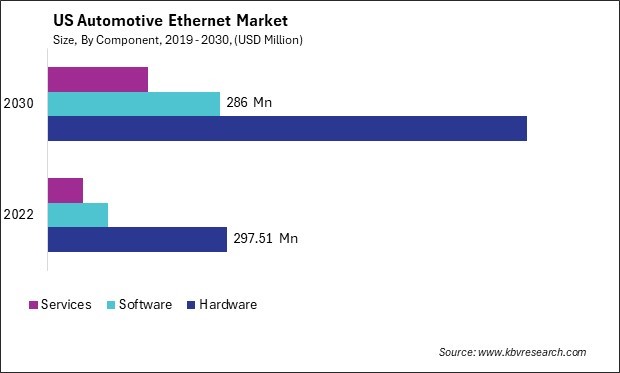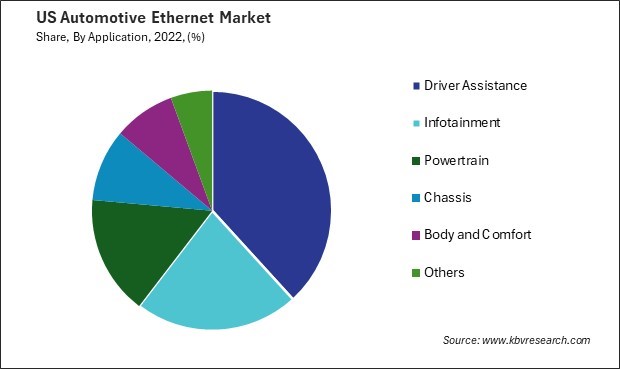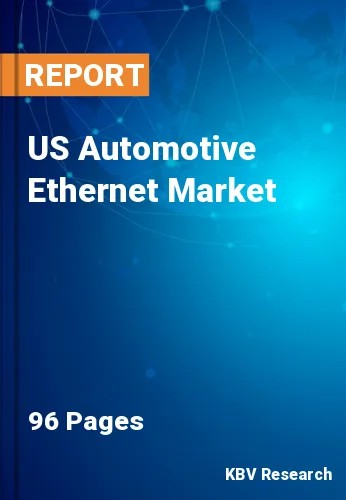The United States (US) Automotive Ethernet Market size is expected to reach $1.2 Billion by 2030, rising at a market growth of 13.2% CAGR during the forecast period.
The automotive industry in the United States has witnessed a significant transformation in recent years, driven by technological advancements and the increasing demand for connectivity solutions. One of the key technological advancements that has gained prominence in the automotive sector is automotive ethernet. Several factors have propelled the adoption of the automotive ethernet market in the U.S. The growing complexity of automotive systems necessitates high-speed, reliable, and scalable communication networks, which ethernet technology provides.

Moreover, automotive ethernet offers advantages over traditional automotive networking technologies such as Controller Area Network (CAN) and Local Interconnect Network (LIN). Several key players, including semiconductor manufacturers, automotive OEMs, and networking equipment suppliers, characterize the automotive ethernet market in the U.S. These U.S. companies are investing heavily in research and development to enhance the performance and reliability of automotive ethernet solutions and to meet the evolving needs of the automotive industry.
However, the COVID-19 pandemic has significantly impacted the automotive sector, including the automotive ethernet market. The pandemic disrupted global supply chains, leading to shortages of semiconductor components and other critical materials used in automotive manufacturing. This resulted in production delays and lower vehicle sales, which, in turn, affected the demand for automotive ethernet solutions.
The automotive industry in the United States has been witnessing a significant expansion, particularly in the automotive ethernet market. The increasing demand for advanced driver assistance systems (ADAS), autonomous driving technologies, and in-vehicle infotainment systems has fueled the need for high-speed, reliable, and secure data communication within vehicles.
According to Select US, international automakers produced 5 million vehicles in the United States in 2020. Total foreign direct investment in the U.S. automotive industry reached $143.3 billion in 2019. In 2020, the United States exported 1.4 million new light vehicles and 108,754 medium and heavy trucks (worth a combined value of over $52 billion) to more than 200 industries around the world, with additional exports of automotive parts valued at $66.7 billion. This expansion underscores the burgeoning presence and influence of the automotive industry, particularly in the automotive ethernet market in the U.S.
Another driving force behind the expansion of the automotive ethernet market in the U.S. is the industry's increasing focus on vehicle electrification and electrified powertrains. Ethernet technology in Japan provides the necessary bandwidth and reliability to support these complex functionalities, thus becoming integral to developing next-generation electric vehicles.
Moreover, regulatory initiatives aimed at enhancing vehicle safety, efficiency, and emissions reduction are also propelling the adoption of ethernet-based solutions in the automotive sector. Standards such as automotive ethernet, defined by organizations like the Institute of Electrical and Electronics Engineers (IEEE) and the Open Alliance, ensure interoperability, compatibility, and cybersecurity in automotive ethernet implementations, fostering industry-wide adoption in the U.S. Thus, the surge in demand for advanced driver assistance systems and vehicle electrification is driving the rapid expansion of the automotive ethernet market in the United States.
The automotive ethernet market in the United States is experiencing a significant surge in demand for connectivity solutions, driven by several key factors. As vehicles become increasingly sophisticated and reliant on advanced technologies, the need for robust and high-speed communication networks within automobiles has become paramount in the U.S. One of the primary drivers of this increasing demand is the rapid proliferation of electronic components and systems in modern vehicles.
Moreover, the rise of connected and autonomous vehicles (CAVs) in the U.S. fuels the demand for automotive ethernet solutions. CAVs rely heavily on real-time data exchange between onboard sensors, processors, and external infrastructure, necessitating reliable, high-speed connectivity solutions. Ethernet technology provides the necessary infrastructure to support the complex communication requirements of CAVs, enabling functionalities such as vehicle-to-vehicle (V2V) communication, vehicle-to-infrastructure (V2I) communication, and in-vehicle networking.
Furthermore, the ongoing digitization of automotive manufacturing processes and the adoption of Industry 4.0 principles contribute to the growing demand for automotive ethernet solutions. Ethernet-based networks facilitate seamless connectivity between production equipment, robots, and other manufacturing assets, enabling manufacturers to streamline operations, improve efficiency, and enhance product quality. Hence, the surge in demand for automotive ethernet solutions in the U.S. is propelled by the increasing sophistication of vehicles, the rise of connected and autonomous vehicles, and the digitization of automotive manufacturing processes, all necessitating robust, high-speed communication networks.

The automotive ethernet market in the United States has been witnessing significant growth in recent years, driven by the increasing demand for high-speed communication networks within vehicles. One of the key players in the U.S. automotive ethernet market is Broadcom Inc. With its extensive portfolio of ethernet solutions tailored for automotive applications, Broadcom has established itself as a leading provider of connectivity solutions for in-vehicle networking. The company's ethernet switches and controllers offer high performance, low latency, and enhanced reliability, meeting the stringent requirements of automotive applications.
Texas Instruments Incorporated (T.I.) is also a significant player in the U.S. automotive ethernet market. The company offers a comprehensive portfolio of ethernet PHY transceivers, switches, and controllers that address the evolving connectivity needs of the automotive industry. T.I.'s ethernet solutions are known for their low power consumption, small form factor, and robust performance, making them ideal for integration into automotive electronic systems.
Another prominent player in the U.S. automotive ethernet market is Marvell Technology Group Ltd. Marvell offers a range of ethernet PHY transceivers and switches designed specifically for automotive use cases. These solutions provide high-speed connectivity while ensuring compliance with automotive industry standards for reliability and safety. Marvell's ethernet products are widely adopted by automotive OEMs and Tier 1 suppliers for various applications, including infotainment systems, advanced driver assistance systems, and telematics.
Additionally, Intel Corporation, a global leader in semiconductor technology, has a strong presence in the U.S. automotive ethernet market with its innovative ethernet solutions tailored for automotive applications. The company's automotive-grade ethernet controllers and switches deliver high bandwidth, low latency, and deterministic performance, enabling reliable communication between in-vehicle electronic components. These solutions enable next-generation automotive systems, such as autonomous driving and vehicle-to-everything (V2X) communication.
NXP Semiconductors N.V., a global provider of semiconductor solutions, is also a prominent player in the U.S. automotive ethernet market. The company offers many ethernet switches and controllers optimized for automotive applications, including in-vehicle networking and automotive gateway solutions. These ethernet solutions enable seamless connectivity between various electronic control units (ECUs) within vehicles, facilitating the implementation of complex automotive systems. These companies play a crucial role in driving innovation and advancing the connectivity capabilities of vehicles, supporting the evolution towards safer, smarter, and more connected automotive systems.
By Vehicle Type
By Component
By Application
Our team of dedicated experts can provide you with attractive expansion opportunities for your business.

